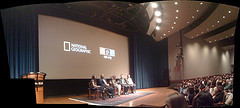*
For the purposes of this blog, I view social media as a set of tools used to create online community -- connections between people. I don't see social media as an end in itself.Most of what I know about building online community is self taught. I talk to people... I see what else is working or not working... I make a few informed guesses and then I dive in. I've worked strategically and hard to push a campaign making use of both an online community I oversaw and other online communities.
It wasn't all successful, but I learned a lot.
Most importantly, I learned that it's a lot harder than it looks.
I knew what the steps were... find and empower mavens within your own community. Try to stand back enough to allow the community to find and speak in its own voice. Use incentives to encourage members to bring in other members, and to behave appropriately. Make sure there is a constant stream of new people coming into the community to keep it alive. Keep on top of your server stats as a real-time indication of what the members of your community want. Establish valuable presences on the other communities you want to participate in as an inexpensive and credible outreach mechanism. Make sure that your participation in those communities is visible so that your rating within the community rises and your content (with your name attached) floats to the top. Set yourself up to be an expert on whatever message you want to push, and then push (ever so gently so that you don't lose your credibility).
I checked these steps with other very smart people who were doing the same thing I was doing. They said the steps were basically right. I skipped gleefully back to implement them. I had six months and a map of steps to take. I was sure I could do it.
I really should have asked those very smart people some more questions, such as
- "did it work?"
- "how long did it really take?"
- "what, exactly, was your definition of success?"
- "were you able to make success happen more than once?"
I think I would have gotten some interesting answers.
Let's break these steps down a bit.
Community growthIn our business, we often joke about the "if you build it, they will come" cliché. Funny how often we still do it. It takes time for a community to build and even longer for it to find its voice. I felt that starting with a relatively small, friendly group who had real-life experience with the topic would be the way to go. I didn't press for a big marketing budget. I figured it would be easier for the mavens to get comfortable and safer for the members to invite friends and coworkers in if it wasn't the digital equivalent of a rave party. It would make community management a lot easier since a small community is a lot less attractive to trolls... and, besides, I didn't have a lot moderator of help.
The community that got built using these assumptions was solid and active... Just small and not growing much. That was considered a failure. There were statistics somewhere that my boss got hold of: it said gave a rule of thumb that if participation a community wasn't doubling in size every month, it was dying. That didn't make sense to me. Communities see so many ups and downs that why should a period of marginal growth be a reason for panic? If the quiet lurkers of the pages continued to increase, is that a success or failure? I wasn't running a community centered around software or games, it was around on-the-ground, off-the-computer community involvement. How much do these "rule of thumb" numbers really apply from one kind of community to another?
I resisted a lot of pressure to just keep heaping more people into the community via marketing or incentives and I wonder how that would have changed things. My gut says that we would have had a huge mess on our hands in terms of moderation and PR (as the one-the-ground action we were trying to generate was child-serving)... but we might have made our numbers.
Community mavensThey come and go so you need to keep a string of "mavens in waiting" going. Setting aside the issues around identifying and engaging these folks, just keeping them "in waiting" a management trick in and of itself. Really good "mavens" tend to be ambitious, outgoing, fairly aggressive, somewhat obsessive "type A" personalities. They are characters. That is what makes them so much fun. It's tough to keep someone like this waiting in the wings -- keeping him or her engaged and excited about your community -- while someone else gets the glory.
I'm not sure that pitting people against each other but allowing them to set up their own competitive cliques is the way to go, either. If your goal is page views, this probably works. If your goal is to get people to work together toward a common goal... probably not.
There are so many options for people that we have very little opportunity to attract and maintain high value participants. If a potential maven comes to my online community and doesn't like the voice or tone or clashes with the current set of mavens, he or she will likely just move on to the next community.
Bringing in new membersI know we got some referrals because people would say so as part of an introduction... but most of our new traffic came from search engines. A person participated in the community (for a long time, consisting only of threaded forums) only if he or she couldn't find the answer to a question in the existing, freely available content. These people did tend to come back and answer other questions, but this was a very small number and they protected their own personal networks like the networks were their children.
According to the "rule of thumb" mentioned above, the community was not growing... and actually qualified as "dead".
We tried the following to kick up registration and participation:
- Google Adwords
- Banner advertising
- Significant mentions on national media
- Celebrity endorsements
- Emails to existing members to increase participation
- Phone calls to existing members to increase participation
- Contests with large and small prizes
The banner ads, national media, and celebrity endorsements were nonstarters. For all the effort involved, particularly with the national media and endorsements, the return was crushingly disappointing. Obviously, there was no money for research so I'm not really sure what the problem was. My guess: People don't always do what celebrities tell them to do, particularly if what they tell them to do is one or two steps removed from what the celebrity is famous for in the first place (like a TV show).
...Or it might be that we just had too big an "ask" in terms of action. (We were asking people to do real-world, community organizing.)
We also experimented liberally on the organization's staff, who were true believers in the mission, but not all of whom were completely bought into or aware of how we were using the Web to further the organizational goals (another unpleasant surprise). We got some interesting insights from that... If you want people to do something, be very, very clear about what that is -- and pay them (through incentives).
Strategically, that wasn't the result we were looking for.
Incentives for behaviorWe found that across the board with all of the contests. If you pay them, people will do what you ask. All of the smart people I was talking to generally considered prizes (paying people for a particular online behavior), a bad idea. It was a Pandora's box, they said. Once you start, you can never stop.
I think that there is a place for contests and prizing in generating activity in online communities, but there is an important trick to it. You have to know what behavior to reward. It's a classic
Hitchhikers Guide to the Universe situation. The answer to life, the universe and everything is 42. If you want the question that led to the answer 42, that's a whole other problem that you should have thought of a long time ago. If you are using contests and prizes to encourage a behavior, make sure that behavior actually supports your goals for the community. If you are asking people to randomly post photos to a site in return for a tee shirt, for example, will that entice them to continue participating? Probably not. They'll post their photo, get their tee shirt and then move on. If your community goal is 1,000 new photos, you are probably OK.
I found myself spending a lot of time and effort on contests that met short-term goals put on me as benchmarks to assess my success and the community's success. It broke my heart every time. While I recognize the importance of measuring the effectiveness of different efforts, that's not the way to build an online community.
Establish personal and credible presences on other communitiesThe challenge here that I completely underestimated was the amount of time required to do this right. Everyone knows this takes a long time. Take that assumption and double it... then double it again. The bigger the community, the harder it is to get noticed. The harder it is to get noticed, the longer you have to work. This is fine if becoming a recognized member of a particular online community is your only goal for the day... but we were also maintaining our web site: creating/updating content, moderating our own community, doing other outreach, analyzing what was working and what wasn't, and building new tech as needed.
Even if I had the luxury of a full-time person focused only on this, however, I'm not sure that would have solved the problem. When I started this effort, I identified at least a dozen targeted communities that I wanted my message visible on. Looking back at my list after a year, only four of those communities really took off and are pulling the kind of audience that would have justified this amount of effort. In order to correctly identify those communities from the start, I would have needed either incredible luck or someone who was paying very close attention to what was happening in the industry. I would have needed someone who was on top of the fact that XYZ community had a bidding war between Disney and Rupert Murdock going on or that the ownership ABC community was really just two sleep-deprived teenagers on a hacked Linux server someplace and that the site would disappear when one of them broke up with his girlfriend.
Thinking the logistics of this through made my head hurt... and made straight-out advertising looks pretty darned attractive.
So I come back to the questions that I would have asked my smart people, had I known then what I know now:
- "did it work?"
- "how long did it take?"
- "what, exactly, was your definition of success?"
- "were you able to make success happen more than once?"
These are the answers I suspect I would have gotten then (and would probably get now).
- "It depends on what you consider success."
- "Dunno, it's not 'done' yet."
- "Ummm, yeah... well... that keeps changing...."
- *shuffling feet* *looking away* "I'm not really sure we got it even once..."
 My husband and I attended a lecture recently about digital storytelling. (Having this sort of thing local almost makes dealing with Washington, DC traffic worth it.) The speakers represented two extraordinary storytelling organizations: National Public Radio and the National Geographic Society.
My husband and I attended a lecture recently about digital storytelling. (Having this sort of thing local almost makes dealing with Washington, DC traffic worth it.) The speakers represented two extraordinary storytelling organizations: National Public Radio and the National Geographic Society.





 As I am clearing the dishes from dinner, I am listening to the father/daughter bonding happening in the dining room and pause for a moment to reflect.
As I am clearing the dishes from dinner, I am listening to the father/daughter bonding happening in the dining room and pause for a moment to reflect.










 As I'm going through job openings, I'm seeing a trend: a rough-and-tumble, take-no-prisoners race toward social media. This isn't a surprise. I could see this coming for some time now as Facebook and Twitter have been racking up the user numbers and corporate leaders started looking at their web analytics and whining "Me, too! I want 10 million users on my site, too!"
As I'm going through job openings, I'm seeing a trend: a rough-and-tumble, take-no-prisoners race toward social media. This isn't a surprise. I could see this coming for some time now as Facebook and Twitter have been racking up the user numbers and corporate leaders started looking at their web analytics and whining "Me, too! I want 10 million users on my site, too!"